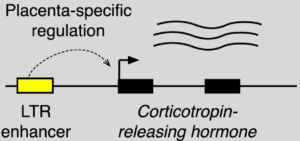

A wonderful example of how viruses can benefit their hosts is revealed by the protein syncytin-1, which is present in the placentas of nearly all mammals. Syncytin-1 is required for development of the syncytiotrophoblast, the layer of cells that separates maternal and fetal bloodstreams. Syncytin-1 was originally a retroviral envelope glycoprotein gene that was exapted by the host for other purposes.
Another example of the benefits of viral infection comes from a study of corticotropin-releasing hormone, CRH, which is produced in the placenta and is thought to regulate the timing of birth. Examination of the human CRH gene revealed a retroviral insertion 2,000 base pairs upstream (pictured; image credit). This insertion, caused by an ancient retrovirus called THE1B that infected our ancestors 50 million years ago, consists of the viral long terminal repeat (LTR), a part of the genome that controls initiation and termination of mRNA synthesis. Analysis of mRNAs suggested that this retroviral sequence functions not as an initiator of transcription but as an enhancer.
When the human CRH gene, including the retroviral LTR sequence, is inserted into transgenic mice, the protein is produced in the placenta. Furthermore, the offspring of these mice are born 15 hours later than usual. Because CRH in mice is normally produced in the brain and hypothalamus, this observation confirms that CRH regulates the timing of birth.
When the retroviral LTR was removed from the CRH transgene, the protein is no longer produced in the mouse placenta, and gestation timing returns to normal. These findings suggest that a retroviral LTR, a remnant of an old infection, was exapted to regulate when birth takes place.
We now know of two examples of how ancient retroviral infections have influenced the function of the placenta, and there are likely more to be discovered. If not for such retroviral infections, mammalian pregnancy would likely be very different. Without a placenta, human embryos might have short gestation times and be nourished in a pouch like marsupials.

Pingback: Retroviruses and the placenta, a remarkable relationship – Virology Hub
Wonderful Life, indeed! It’s incredible that anyone could have discovered this. :O